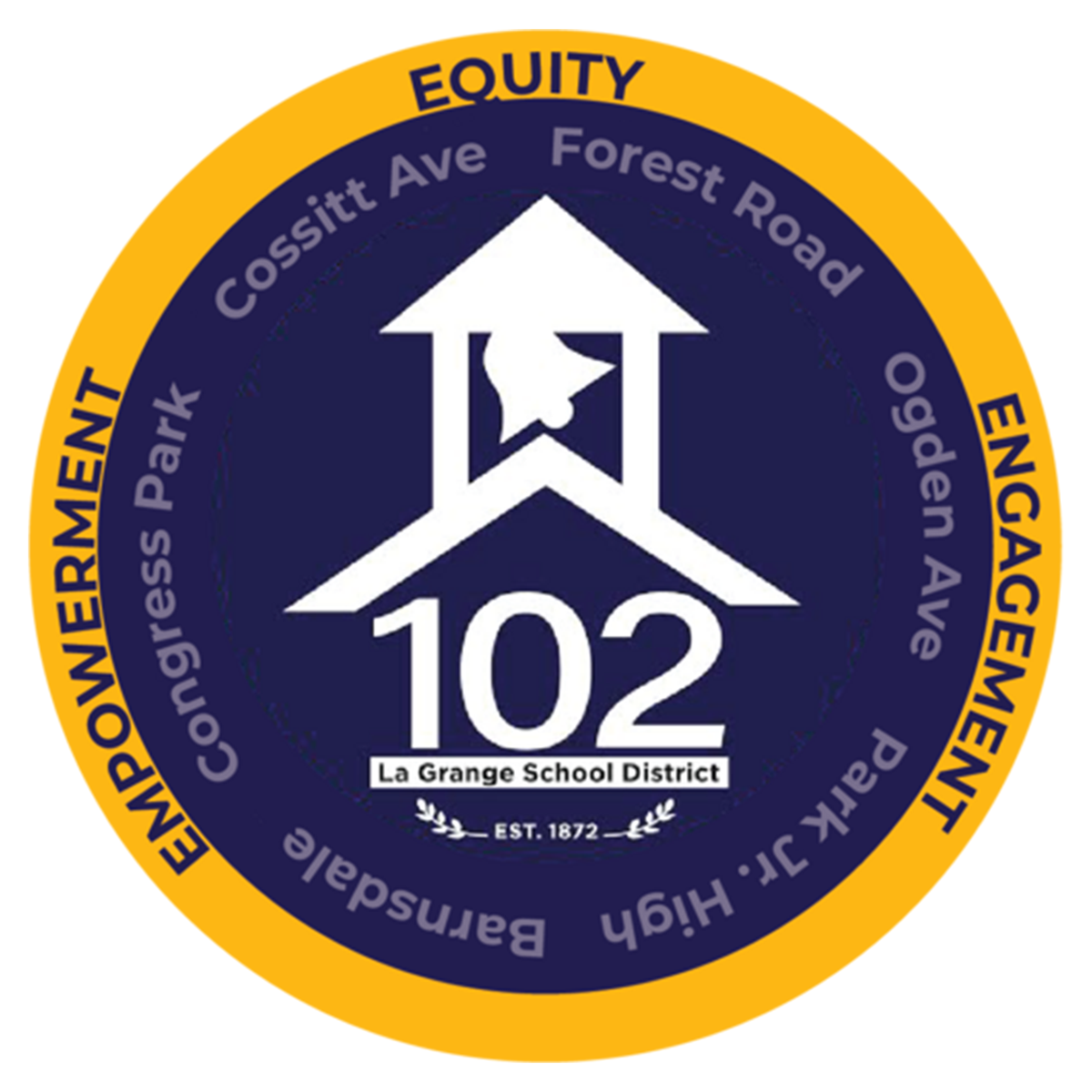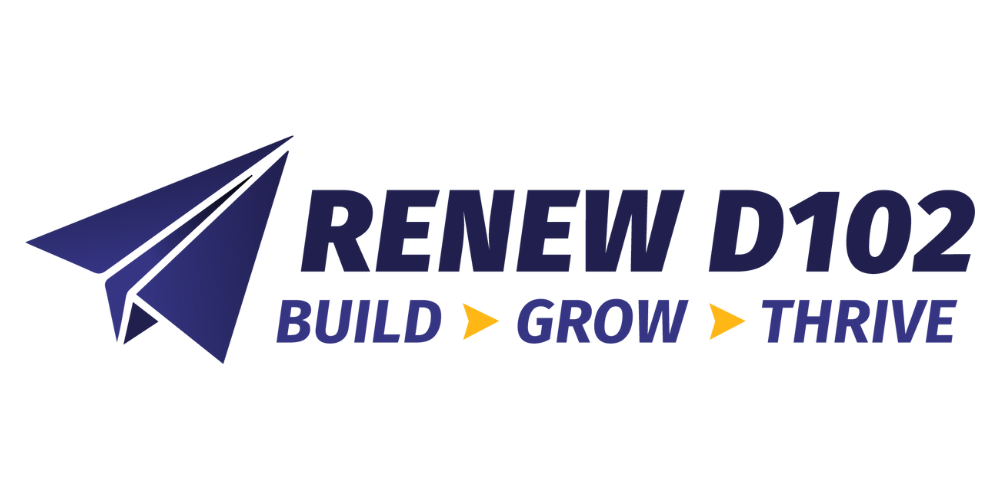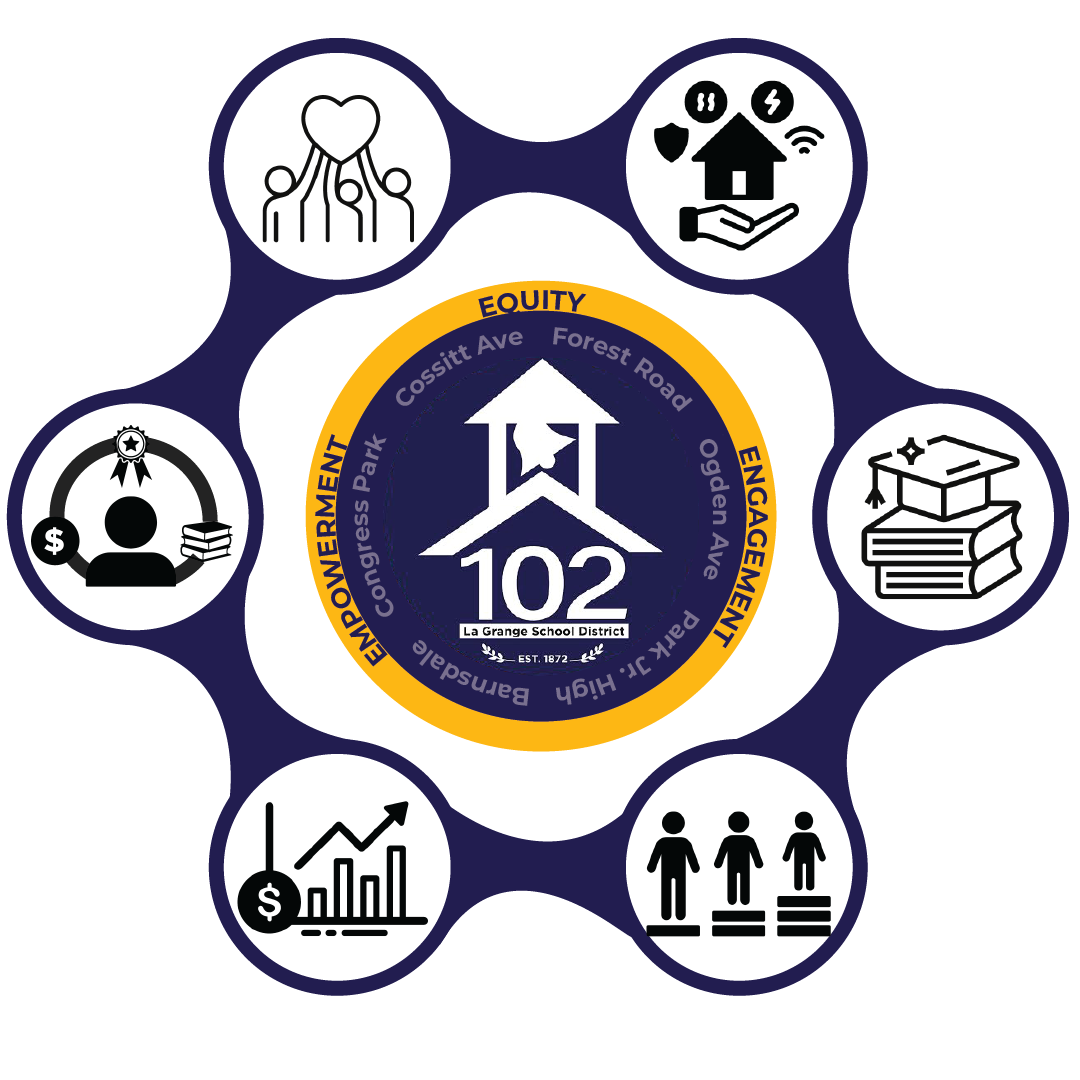The Community-Created RenewD102 Plan
Q. What improvements will be made?
The Renew D102 Plan is designed to address the district’s most pressing facility needs while creating learning environments that support student success now and in the future. This comprehensive plan focuses on improving the safety, accessibility, and functionality of our schools to better serve all students.
Key improvements will:
Alleviate Overcrowding
Upgrade Safety and Security
Improve Accessibility
Update Classrooms, STEM Spaces and Labs
Repair Aging Infrastructure
Q. Why do our buildings need to be updated?
Three of our schools are more than 100 years old, and many have systems that are showing their age. From outdated plumbing and electrical infrastructure to overcrowded classrooms and students learning in hallways and stairwells, we need to consider updating our schools to meet the needs of students now and into the future.
Q. How did D102 develop a plan to identify its needs?
Since September 2024, the community-led Renew D102 Facilitating Team has been hard at work, carefully reviewing data and gathering input to address these challenges and shape a long-term plan for the future of our schools.
With feedback from the community, the district’s strategic goals, an in-depth look at our school facilities, and a review of educational best practices, they developed three options to address our needs. These options were shared during a community workshop on October 29, where residents provided valuable feedback. That feedback helped refine the team’s preferred option, the RenewD102 plan, which was then shared through a community-wide survey and at open houses across our schools.
Q. How does this plan reduce overcrowding?
The Renew D102 Plan takes a strategic approach to reducing overcrowding while enhancing learning opportunities for all students. It’s essential to create spaces that support both academic and extracurricular needs now and in the future. Key strategies to reduce overcrowding include:
Optimize existing and new spaces to reduce overcrowding and provide room for academic and extracurricular opportunities to best meet the needs of students now and in the future.
Shift to a 6th - 8th grade middle school model to better support students academically, socially, and emotionally while opening up much needed space in all elementary schools.
Modernize existing classrooms and build new classrooms to create spaces that support current and future learning needs, with the flexibility to adapt to different student learning styles and needs while seamlessly integrating technology and hands-on learning opportunities.
Q. Why move to a 6-8 middle school?
The D102 Plan proposes shifting to a 6th - 8th grade middle school model to better support students during a period of academic, social, and emotional development. This transition is designed to create an environment tailored to the unique needs of middle schoolers, offering age-appropriate learning experiences while also addressing overcrowding in elementary schools. Nearly all LT High School feeder districts use 6-8 or 5-8 middle school models, meaning our students will enter high school with similar experiences and preparation.
By moving the 6-8 middle school, the district can:
Renovate and add classrooms to support middle school grade-level teaming
Renovate and add science labs
Renovate the cafeteria
Create an updated secure entry
Renovate and add locker rooms and bathrooms
Q. Why create STEM labs in each elementary school?
Creating STEM (science, technology, engineering and math) classrooms will modernize facilities that support current and future learning needs, with the flexibility to adapt to different student learning styles and needs while seamlessly integrating technology and hands-on learning opportunities.
Q. What happens to the Science Center?
The plan includes creating a dedicated STEM lab classroom at each elementary school, giving students more frequent access to hands-on science learning right in their own schools. These new labs would be school-specific versions of the current District Science Center. This shift opens new opportunities for the current Science Center space at Barnsdale to be repurposed for additional office and collaboration spaces and programs, reducing overcrowding in other areas of the building. The Science Center's learning resources and animals will be distributed throughout the district, ensuring they continue to benefit students throughout D102.
Q. What is the construction timeline for the updates?
The renewal plan would take shape in phases over the course of the next three school years. The District would engage project managers and entertain competitive bids for all projects starting in the spring of 2025. The goal would be to complete external construction throughout each of the next three years so as to not displace students or cancel any existing student experiences (academic and extracurricular). All internal classroom renovations would take place during the summer months. The optimal completion date for all projects, including the opening of Park as a 6-8 junior high would be fall of 2027.
Q. What happens if economic conditions change and costs for projects increase?
Changes to economic conditions and project costs are a near certainty. As is customary and expected with large projects of this nature, all bid proposals and project management companies would include predicted and incidental changes into their pricing. Part of the initial planning process also included estimated increases for a multi-year project.
Q. Why should we do this work now and not wait until later?
Three of our schools are more than 100 years old, and many have systems that are showing their age. From outdated plumbing and electrical infrastructure to overcrowded classrooms and students learning in hallways and stairwells, we need to consider updating our schools to meet the needs of students now and into the future. The longer we delay, the more these issues will worsen, potentially adding even more critical needs to the list, such as increased safety risks and further deterioration of infrastructure.
By addressing these concerns now, we can avoid escalating costs in the future. Delaying necessary repairs and upgrades will not only result in higher maintenance costs but could also disrupt the learning environment, impacting the quality of education we provide. Taking action now ensures that we are investing in a safe and efficient learning environment for students today and for generations to come.
Q. Beyond improving our schools, how will the bond issue help the community?
Schools are a primary factor many people consider when deciding in which community to live. Quality schools have a positive effect on property values. We are committed to protecting our community’s investment in our high schools by keeping them in good working condition.
Q. Will any of the bond proposal funds go toward areas other than building needs?
D102 is required to use funds as specified in the proposal listed on the ballot. These projects are all related to improvements at our buildings and/or on the grounds of our facilities and the funds will be used to do just that.
Q. What happens if this proposal is not approved by voters on April 1, 2025?
If voters do not approve the April 1, 2025 referendum, the needs in our buildings would remain and still need to be addressed. The Board of Education would discuss next steps and communicate those to the community.
Q. What is the district’s current bond rating?
Based on strong and steady academic performance over the last few years, District 102 received an elevated bond rating in its last valuation in September of 2024. The current bond rating for District 102 is AA-.
Q. How was the community involved in developing this plan?
The Renew D102 plan was created through months of collaboration among parents, educators, and community members who worked together to address some of the biggest challenges facing D102 schools. This team, known as the Renew D102 Facilitating Team, began meeting in the fall to put the program together and continued to meet regularly to provide coordination and leadership. While this team was responsible for putting the program together, decisions about the future of our schools were made based on feedback from the community engagement sessions. It focused on updating our aging school buildings, improving safety and accessibility, reducing overcrowding, and creating spaces that met the needs of students both now and for future generations.
Finances
Q. How much are these improvements expected to cost?
The Renew D102 Plan is a comprehensive effort to create safe, accessible, and future-ready learning environments for all students. It focuses on maintaining and upgrading essential infrastructure, enhancing safety with secure entrances and updated security systems, improving accessibility through new elevators and inclusive playgrounds, reducing overcrowding with optimized classroom spaces and STEM rooms, and transitioning Park to a 6th–8th grade middle school to better support student growth. To make these critical improvements a reality, the plan includes an $81.7 million investment that will benefit students, staff, and the community for years to come.
Q. Is D102 contributing anything toward the facility improvements?
D102’s annual expense budget includes about $2M for operations and maintenance of our facilities. We also recently acquired non-referendum bonding of $8M to complete some smaller facility improvement projects. However, these amounts are not sufficient to complete the necessary larger scale capital improvement projects.
Q. How is D102’s current financial health?
Based on its annual external audit and publicly available financial statements the district has sustained financial stability and is currently meeting the state minimum requirement for fund reserves at 25%. Balanced budgets have also been achieved within the last few years.
Q. If the proposal does not pass, will my tax bill go down?
Not necessarily. The taxes paid are a result of the specific assessed value of your property as it compares to the property growth of the district. A failed referendum would result in lower taxes paid to D102 compared to an approved referendum as noted in the question above. However, if the proposal is not approved, taxes may not decrease. Typically, tax bills see increases consistent with the rate of inflation annually but actual amounts will vary by the individual property. If a property is reassessed by the township or if the property has an improvement made (e.g. an addition / increased square footage) this, too, will impact the tax bill. Many of these factors are not within the control of the school district directly.
Q. When was the last time D102 asked voters to approve a bond referendum?
The last time D102 voters approved a bond referendum was in 2001. The $13.9 million proposal updated building systems throughout the district, funded classroom additions at Congress Park and Ogden as well as the Ogden gym addition.
Q. What is the cost to property owners if the April 1, 2025 referendum passes?
If the April 1, 2025 referendum passes, the estimated cost to property owners will vary based on home value. For example, the owners of a $400,000 home would pay approximately $34.83 per month (or about $1.15 per day). For a $500,000 home, the cost would be around $44.33 per month, and for a $600,000 home, about $53.83 per month. These funds will support critical improvements in safety, accessibility, and learning environments across D102 schools. For more details on the cost of the full plan, visit https://www.dist102.k12.il.us/page/renew-d102-home-page.
Q. How was the decision made to place the referendum on the ballot?
The plan to improve our schools was created through months of collaboration amongst parents, educators, and community members who worked together as part of the RenewD102 community engagement program to address some of the biggest challenges facing D102 schools. It focuses on updating our aging school buildings, improving safety and accessibility, reducing overcrowding, and creating spaces that meet the needs of today’s students—and those of future generations. In January 2025 the District 102 Board of Education unanimously voted to place the Renew D102 plan on the April 1, 2025 ballot.
Q. Is doing nothing to address our facility needs an option?
With a strong history of quality schools, our community is at a critical crossroads. While it might seem easier to delay action, doing nothing to address our facility needs is not a sustainable option. The challenges facing our schools—aging infrastructure, safety concerns, overcrowding, and accessibility issues—will not resolve on their own. In fact, deferring action will lead to higher costs and more urgent problems in the future.
0–5 Years: The district faces $35 million in immediate needs, including recommended safety improvements and projects tied to outdated systems at the end of their useful life.
6–10 Years: The condition of school finishes and equipment will shift from fair to poor, but critical code-related upgrades (like sprinklers and ADA improvements) may become mandatory, increasing costs.
11–20 Years: Without proactive investments, the cost of addressing these needs will rise significantly. Equipment failures, emergency repairs, and code compliance issues will strain the district’s budget, potentially diverting resources from educational programs.
Q. Can D102 use its current budget to address facility needs?
While the district’s budget is allocated for ongoing operational expenses and emergency reserves, it is not sufficient to cover the large capital costs required for necessary facility improvements. The state of Illinois mandates that D102 maintain a minimum 25% fund balance, which acts like a savings account to ensure the district can respond to emergencies and unforeseen circumstances.
Currently, D102's reserves are projected to remain close to this minimum requirement over the next five years, leaving little room for large-scale capital projects. While $20 million has been identified to accelerate some immediate needs through the RenewD102 Plan, the remaining facility assessment needs will need to be addressed gradually through the district's budget over the next decade.
Q. How do school districts fund facility projects?
Capital improvements (facility projects) can be funded in one of three ways in Illinois:
Operating Budget - This approach uses operating funds to fund capital projects at the cost of redirecting that money from funding instruction. Projects can be funded directly from operating funds or through issuing operating debt or Alternate Revenue Source Bonds.
Prior Year Surplus - Using money left over from a previous year is another way to fund facility projects. However, this is not a reliable source of funding or one that allows for long-term planning.
Referendum Debt - This is the primary method for K-12 public schools in Illinois to fund facility projects. It requires a simple majority approval by voters in a school district.
Election Day & Voting Information
Q. How will the D102 bond proposal appear on the ballot?
By law, the bond proposal must appear on the ballot in this form:
Shall the Board of Education of LaGrange School District Number 102, Cook County, Illinois, improve the sites of, build and equip additions to and alter, repair and equip school buildings, including but not limited to improving safety, security, and student accessibility to educational and outdoor spaces, updating roofs, plumbing, electrical and HVAC systems, renovating academic and extracurricular spaces, increasing classroom space and constructing STEM (science, technology, engineering and math) labs, and issue bonds of said School District to the amount of $82,000,000 for the purpose of paying the costs thereof?
Q. When is the election?
The election is April 1, 2025.
Q. How does an individual register to vote?
According to the Cook County Election Division website, an individual must register at least 28 days prior to an election in order to vote in that election. They may register online, by mail, or in person. Following the close of registration, Illinois allows for "Grace Period" Registration and Voting beginning the 27 days prior until the day before an election. Online registration is available through the 15th day prior to Election Day. Voter registration is available on the Cook County Election Division website or by calling (312) 603-0906.
Q. Who can vote?
All registered voters in La Grange District 102 are eligible to vote in this election. Residents may also request absentee ballots and find a complete list of election dates by visiting the Cook County Election Division website or calling the Cook County Election Division at (312) 603-0996 for additional information.
Q. When does early voting begin?
Early voting starts March 17, visit the Cook County Election website here for early voting locations and details.
Q. How can an individual vote by mail?
Any eligible D102 registered voter may Vote by Mail beginning 40 days prior to an election. Details are available on the Cook County Election Division's Vote by Mail page. Request a vote-by-mail ballot on the Cook County Election Division Website. or call (312) 603-0946.
Q. Why is the community required to vote to improve our schools?
In Illinois, whenever a school district wants to issue bonds to build new or improve existing facilities, it must first seek the approval of voters in the district.
Q. What is a bond referendum?
A bond is much like a personal home loan, and is a way for government entities, such as school districts, to borrow money for large projects and repay them with future tax proceeds. An individual generally approaches a financial institution for a mortgage because they don’t have the means to pay for their home with one large initial payment.
Q. How many yes votes are required for the bond referendum to pass?
A simple majority (50 percent +1) is required for the referendum to pass.
Q. Where can I learn more?
Learn more at Renewd102.com.


